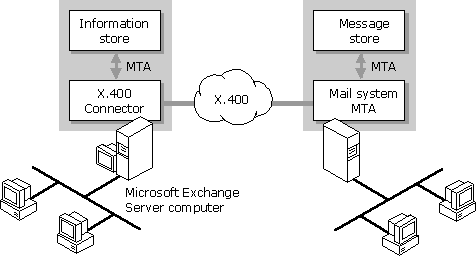| Concepts and Planning | << | >> |
Connections to Foreign X.400 Systems
To connect to foreign systems compliant with the 1984 or 1988 X.400 Recommendations, use the X.400 Connector. The following illustration shows the routing system.

To create this type of connection:
- Install and configure the necessary Windows NT Server network software and hardware on a Microsoft Exchange Server computer in your site or organization.
- Set up a Microsoft Exchange Server X.400 MTA transport stack that corresponds to the installed network software and hardware.
- Define a new X.400 Connector that specifies how to connect and communicate with the MTA of the other X.400 system.
- Configure the necessary network software and hardware on the other X.400 system.
- Configure the other X.400 system's MTA to match the configuration of the Microsoft Exchange Server MTA.
When this process is complete, Microsoft Exchange Server can connect and transfer messages to and from the other X.400 system. If additional routing information is configured, messages can also be sent and received from indirectly connected systems.
Backboning over Public X.400
You can connect to another Microsoft Exchange Server site or organization using a public X.400 carrier or another X.400 system through an X.400 Connector. This process is shown in the following illustration.

To create this type of connection:
- Set up message transfer from each Microsoft Exchange Server site to points of connection (MTAs) for the public X.400 carrier (as shown in the illustration), and then verify that messages are correctly routed between each site and its point of connection.
- The points of connection to the public X.400 carrier consist of MTAs, and are either directly or (more likely) indirectly connected to each other as well as to other MTAs.
- Set up routing between the two public X.400 carrier points of connection so that messages from either point are routed to the correct Microsoft Exchange Server site.
- Add the X.400 e-mail address of each Microsoft Exchange Server site to the other X.400 Connector address space so that messages for the other site are correctly routed to the public X.400 carrier.
When this process is completed, each Microsoft Exchange Server site can exchange information with the other site over the public X.400 carrier.


